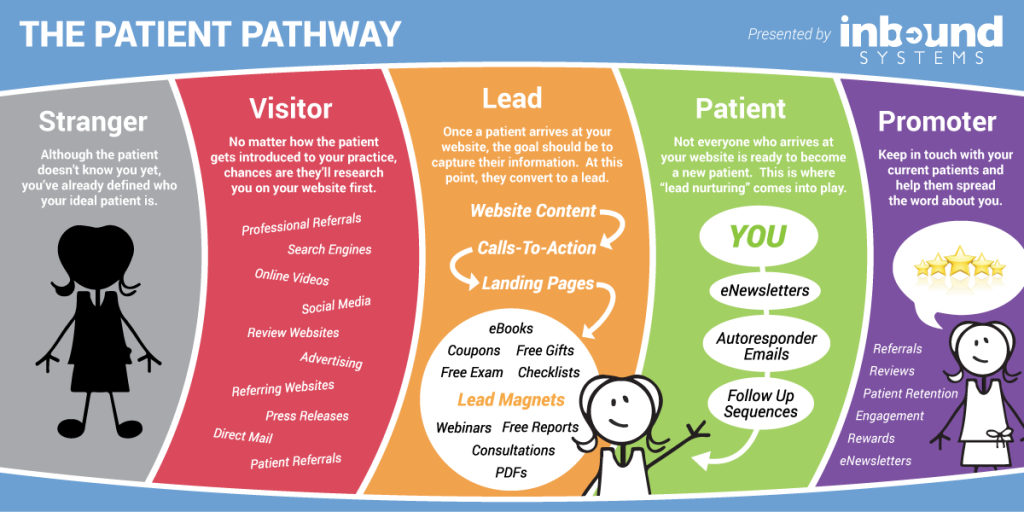- You are here:
- Home »
- Uncategorized
Category Archives for Uncategorized
MARKETING FOR DENTISTS: UNDERSTANDING THE PATIENT PATHWAY
“If you build it they will come” does not apply in this day and age when it comes to your practice. Marketing for dentists means attracting the right patients, and it’s not as simple as opening up shop and waiting for the phone to ring.
Digital marketing works in phases. Though some people are looking for a dentist right away, most of your potential patients conduct research on several dentists before they make a choice. Once they visit your website, you can’t just assume they’re ready to plop down in your dentist’s chair.
Your patients need to see your passion and expertise when they’re researching your practice. They also need to know what kind of person you are. Useful, audience-oriented content turns a visitor into a lead. Leads aren’t always ready to commit right off the bat, so a patient might not go straight from a Google search to your waiting room.
They need time to think and do research, and you need to nurture them along the way.
There is a natural sequence for turning strangers into new patients and promoters. See for yourself…

(click to enlarge)
The 5 Phases Patients Experience
These five phases represent your potential patient’s journey, from stranger to promoter. As they research your practice, give you their contact information in exchange for useful content, and eventually become a patient, you have the chance to delight them every step of the way.
Phase 1: Stranger
Before they booked their first appointment, each of your patients were a stranger to your practice. They didn’t know what to expect and they didn’t know how you operate until they entered your waiting room and reached the end of their appointment.
That’s where your potential customers are starting– as strangers. But who are your potential patients? You need to define your potential patient, a process known as “defining the buyer persona.”
To turn strangers into visitors, you need to craft a marketing message that resonates with your ideal patient. What are their fears? What are their concerns? How can your services turn them into a better version of themselves?
Your marketing message should reflect your ideal patient’s needs. You should solve their problems and explain the tangible benefits of choosing your dental practice.
Phase 2: Visitor
Your marketing message has to reach the stranger where they hang out, online. It might be as simple as finding your website with a Google search, or it might be because a friend recommended you to them on Twitter.
Ideally, you should engage your potential patients everywhere they spend time online. Social media, search engines, forums, review websites– the more, the better.
In the end, it doesn’t matter how they heard about you. If they’re interested, they’re going to visit your website. That’s why the next step is so important.
Phase 3: Lead
Most dentist’s websites skip this step, which is good news for you. If you’re the only dentist in your area proactively capturing leads, it creates a profitable opportunity for your practice.
The goal during this phase is to convert your website visitors into leads, which allows you to thoughtfully follow up with them until they become patients.
I like to think of a lead as someone who has “raised their hand” and exchanged their contact information for valuable content. We call that valuable content a “lead magnet.”
My team and I create lead magnets for dentists all the time, so we know they work. If you want to create one, you need to focus on what your patients want to know. How can your knowledge add value to their lives? If you’re interested in creating your own lead magnet, I recommend starting with this article from DigitalMarketer.com.
Good news! Most doctor websites skip this step, thus creating a profitable opportunity for your practice. The goal here is to convert your website visitors into leads, allowing you to follow up with them until they become patients. What’s a lead? Someone who has “raised their hand” and has provided you their contact information in exchange for something else of value (a.k.a. a “lead magnet”).
Phase 4: Patient
When they arrive at phase four, your leads have not given you any money. Unfortunately, not every lead is ready to become a patient, yet. That’s why it’s important to engage your leads, with content they’ll find useful and interesting, after they’ve given you their contact information.
We call that process “nurturing.” eNewsletters, autoresponder emails, and follow up sequences help keep you on the top of your lead’s mind– without seeming overly pushy.
Basically, you’re keeping in touch until they become a new patient.
Phase 5: Promoter
Finally, the stranger-turned-visitor-turned-lead is your patient. Congratulations!
Don’t stop here, though. Your current patient base can be cultivated to expand your online visibility, and they can help grow your practice with word of mouth referrals. Even after they’ve left your practice, you should continue to inform and delight them
The patient becomes a brand advocate or promoter. They’ll help you market your practice because they like you so much.
Applying the Patient Pathway to Your Practice
Sure, this is good information and all, but how does it apply to your practice?
Great question. Unfortunately, there’s no one-size-fits-all answer. It’s like a patient calling your office over the phone and, without an exam and consultation, asking you to fix a toothache.
Every practice is different, and yours is no exception. Marketing for dentists isn’t a cookie cutter affair.
To move a potential patient through all five phases of their journey, you’ll need to do some work. That means identifying your ideal patient, figuring out how to meet their specific needs, creating useful content, getting their contact information, keeping in touch, and delighting them even after they’ve become a patient.
If you need any help along the way, I suggest you take a look at our free cheat sheets for dentists, or just give me a call.
To your marketing success!
EMAIL MARKETING FOR YOUR DENTAL PRACTICE
Are you having trouble capturing leads with your website? Are you having trouble converting leads into patients? Do you often feel like you’re not properly marketing yourself to existing patients?
Do you feel like they’re forgetting you?
 If so, let me pose a few more questions:
If so, let me pose a few more questions:
Does your dental practice have an email list? Do you actively seek out email newsletter signups? Are you trying to capture emails from your current and potential patients?
If you answered “no” to any of these questions, it’s time to reconsider.
How often do you check your email, even when you’re at home or on the go? 72% of online adults send and receive email from their smartphonesat least once per week.
According to an in-depth study from Merkle, 74% of people say email is the method of choice when it comes to commercial communication. It edges out direct mail five to one. People of all ages use email, though the number drops off slightly at around 65 years of age.
Since mobile usage is on the rise (and isn’t showing any signs of letting up), it’s also important to think about how people interact with email on their mobile devices.
According to the Pew Research Center,
Email has long ranked as one of the most common activities that users take part in online since the desktop/laptop era, and it continues to play a prominent role in the mobile era as well. Some 88% of smartphone owners used email on their phone… making email a more widely-used smartphone feature than social networking, watching video, or using maps and navigation, among others.
The numbers tell us people still actively use email, and they prefer it for marketing-related communication.
Email marketing for dentists works. Are you ready to take advantage?
The Inbox Connection
Can you imagine someone looking forward to an email from their dentist? It’s tricky, but it’s totally possible.
If you approach email marketing the right way, it forms a connection with your patients and your leads. Focusing on their interests and their needs, instead of singing your own praises or running headlong into self-promotion, means they’ll look forward to reading your emails.
Another plus– Email marketing is both effective and cost-effective.
From inbound marketing software giant HubSpot:
Companies using email to nurture leads generate 50% more sales-ready leads and at 33% lower cost. And nurtured leads, on average, produce a 20% increase in sales opportunities compared to non-nurtured leads.
Email is also nearly 40 times better than Facebook and Twitter for acquiring new customers (or patients), according toMcKinsey’s exhaustive research.
Not everyone on your list will open your emails, no matter how good your subject line and your content is. Some people will unsubscribe. Patients you see twice a year will unsubscribe. It’s a fact of life.
You can’t craft an email that resonates with absolutely everyone, and not everyone wants another email in their inbox every month or so.
You can focus on providing value, speaking to your patients and leads’ wants and needs, and following email marketing best practices, though– and you’ll reap the benefits.
Building Your List
Before you connect with your current and future patients, you need to build your email list. They can’t sign up if there’s no way for them to opt in, and you can’t get in touch with them if you don’t have the necessary software.
Sure, you can build a list, compose a message, and input every email address in by hand, but it’s not efficient. You’re busy running your practice, and your team members are busy with making appointments, financial consulting, and helping you care for your patients. You need a quick solution that still affords your patients the personal touch they expect from your practice.
So, you need an email marketing service. Several reputable companies offer free plans that should allow you to send enough emails, per month, to satisfy a growing list. If your needs outgrow the free service, you can always upgrade later.
As far as free services for local practices go, I recommend:
If you have a dedicated marketing team and have more resources, you can go even further with your email marketing. These services have powerful analytics and customization tools:
As you grow your list and find the need for more features, list segmentation, and analytics, you’ll probably outgrow the free services. Or you might not. It depends on your goals and the size of your practice. Whatever the case may be, you have plenty of good options for email marketing software.
Once you’ve chosen your software, you’ll need to set up an email signup form on your website. Ideally, you’ll place it on the homepage and in your sidebar, so it can be accessed on most any page. Nearly any email marketing service you sign up for will provide forms and support. Ask your IT department if you need help integrating these forms.
Unfortunately, you can’t just place a signup form on your homepage and hope people will opt in. Your loyal patients might sign up but, for everyone else, you’ll need to give them an incentive.
Here are some ideas:
- Lead Magnets – In the digital marketing world, we call any piece of content a lead might want to exchange their email address (or any other information) for a “lead magnet.” For a dentist, that could mean a fun two-minute video that gets a child through toothbrushing time, a guide on which foods to avoid if you have braces, or informative literature on sleep apnea. Basically, your prospective patient signs up for your email list in exchange for useful content.
- Content Upgrades – Say you have a great blog post about foods you should avoid when you have braces. You can offer a better, more informative version of that same content (“Bonus content”) as an exclusive if a lead signs up for your email list. We call this tactic a “content upgrade.”
- Sample Newsletters – Want people to opt in to your email list? Show them your content is worth their time. Create a page on your website that features past newsletters– these sample newsletters will show them exactly what they’re getting. This only works if your email newsletters are worth their time, of course. So don’t showcase shoddy work or cookie-cutter newsletters.
- Receptionist – If your patient has a great visit, you might have your receptionist ask them if they’d like to sign up for your email list. Your receptionist will have to express the value of joining the list, and they’ll have to be comfortable pitching it to the patient. Sometimes the human touch is great for signups.
- Referral System – You can offer your existing patients discounts and other goodies if they refer a friend or family member to your email newsletter. It’s difficult in the dental world, so your patient will have to actually enjoy your newsletter in the first place. If this sounds like something you can pull off, there’s a nice guide here.
- Giveaways and Contests – People love giveaways and contests, and they’re a great way to score some signups for your email list. To enter, they simply have to sign up. You’ve likely entered one or two of these contests or giveaways yourself. Just make sure you offer the giveaway or contest to your existing subscribers, too– you don’t want to alienate loyal patients.
There are other ways to encourage people to sign up for your email list, too, of course. Some of them are more intrusive than the options I listed, but they still work. KISSMetrics has a great post on the subject, and I encourage you to read it if you want more ideas.
Email Marketing Best Practices

Once you’ve built your list, you have to send out an email. Ideally, your leads will open the email, read the content, and become further engaged with your practice.
A successful marketing email has an appealing subject line, compelling content, and value for the reader. It’s also sent out at the right time. You want to avoid sending emails too frequently, or your leads will either get annoyed or just become fatigued by your emails. You’ll also need a sensible, effective call-to-action in each email.
Subject Lines – According to MailChimp, the best subject lines are straightforward. They’re not pushy or overly sales-oriented.
They also have this to say about the worst subject lines:
On the “worst” side, however, notice how the subject lines read like headlines from advertisements you’d see in the Sunday paper. They might look more creative, but their open rates are horrible. It’s as if those email marketers assumed that subject lines have to jump off the screen and GRAB THE READER’S ATTENTION! or something. Unfortunately, most people get so much junk mail in their inbox, anything that even hints of spam gets thrown away immediately.
Your subject line needs to grab attention, too. Here’s a great resource from MailCharts about effective short subject lines. It also references which words tend to draw the human eye and brain. I recommend keeping your subject lines under 50 characters– otherwise they get cut off in your lead’s inbox.
Content – Now that your current or future patient has opened your email, it’s time to make it worth their while. Write content with a goal in mind. Obviously, you want to engage them. You want to stay hovering around the top of their mind. Each email should have a goal, though, whether it’s booking appointments for a teeth cleaning or reminding them they need to get their braces checked.
Content can and should contain:
- Personalization – Write the email like a personal letter, sent from you, the doctor. Keep it professional, but also keep a friendly tone– like you’d address another doctor or a respected friend.
- Humor – Dentists love to laugh. Patients love to laugh. If you (or someone at your practice) is naturally funny, use it to your advantage. If you make one of your subscribers laugh, they’ll be much more likely to open your future emails.
- Stories – Within this personal letter, tell a brief-but-interesting story. You live interesting stories every day, so it shouldn’t be a problem. If you can weave humor into your story, that’s even better.
- Theme – You want to keep your email to one overall theme. If you’re all over the place with your content, your reader is likely to get confused and move on to something else.
- Length – Keep it short. A few paragraphs for your main content is more than enough.
Value – Value goes hand in hand with content. Your content has to be useful and valuable to your subscribers. Value can come in the form of humor and stories, but you also want to prove your expertise as a dentist. Give a few helpful tips with each email. Offer discounts if you can. Share coupons for dental products– if you endorse Sonicare products, for instance, find a coupon and pass it on to your email list. You have to make opening your email worth their time.
Community – Encourage a sense of community with your subscribers. Mention a local event or two. Mention a local charity or fundraiser, and tell them how they can get involved. It can be simple, but nothing endears a local practice to its patients like being active in the community. Show your community pride through your email marketing.
Call to Action – Each of your emails should have a call to action with a link. The link can go to a landing page, your “contact us” page or anywhere you’d like your subscribers to go. Keep it simple and direct, and don’t be too pushy.
Time and Frequency – Sadly, there’s no surefire perfect time to send your email. It depends on your audience. If most of your patients are young people and college-aged kids, you might want to try sending emails at night. That won’t fly with people in their 40s and 50s, though.
Smart Insights says the best time for healthcare professionals to send emails is in the hours before 10am. That’s a great starting place. Tuesdays and Thursdays are also popular times to send email, but you might have a better response on Wednesday. You’ll have to test and see when your emails perform best.
Here is a list of six case studies that show when successful emails are sent.
Here’s a comprehensive guide on how to test your email marketing performance.
There are no shortcuts. You have to know your audience and test your emails relentlessly. That being said, don’t get discouraged when your open rate or click through rate or low. Just adjust, try again, and get better.
Word of mouth will always be your best friend when it comes to getting new patients in the door, but it’s not always steady or reliable. With email marketing, you can make a real connection and reliably keep new patients coming in the door. Email marketing for dentists is an under-utilized and highly-effective tactic.
We live in the age of email, and it’s not going away anytime soon. Email marketing is an excellent way to connect with your existing patients, and it’s also one of the best ways to nurture people into becoming your future patients. If you work at it and follow best practices, people will look forward to getting an email from their dentist every month.
To your marketing success!
10 BLOG IDEAS FOR DENTISTS
“If you want to market your business online, you need a blog.”
You’ve probably heard and read that phrase a dozen times, but how does it actually apply to you? How does blogging for dentists even work?
Clothing retailers, restaurants, photography studios, and other more “glamorou

s” industries have it easier, that much is true. People love reading about fashion, food, and art. Compared to those businesses, you have your work cut out for you.
But I can tell you right now, you can build a killer dental blog that will delight your current patients and influence your potential patients’ purchasing decision during their research phase. Blogging doesn’t have to be a struggle and your blog doesn’t have to be boring.
Before we get to the ideas, I want to put a little extra propulsion behind your blogging success. Once you understand the ‘why’ and the ‘how,’ the ‘what’ becomes much more powerful.
Why Blogs Are Important
Your blog is the best place to share your ideas, your expertise, and your creativity. Your blog shows potential customers why you’re different than your competitors. Think of it as a museum (or a storehouse) that puts your best work on display.
Some statistics:
- 61% of American online consumers make purchases based on recommendations or research from blogs.
- 81% of online consumers trust information and advice from blogs.
Those numbers come from a comprehensive study by BlogHer in 2012 and those numbers have only increased since then.
Blogs answer your potential patients’ questions. They help your business build a sense of community and create brand advocates. They can also gather leads.
A compelling, relevant blog, combined with an effective email signup form, can keep leads coming in at a steady flow. If you play all your cards right, the people on your email list will be excited to hear from you and read another blog post. Possibly even sharing it with their friends.
Your blog can make a difference. And it doesn’t have to be boring.
Start Telling Stories and Never Stop
So, how do you separate your blog from the rest?
After you’ve considered some of the ideas in the next section, focus on telling a story. Make the story relevant to your audience. Craft it with a beginning, a middle, and an end.
People connect with stories, especially if the stories are essentially about them. If your potential patient has a “that’s me! I do that all the time!” moment when they’re reading your blog post, they’re already on the way to liking you and trusting you.
If you want the science of stories and selling, check out this video from neuroeconomist Paul Zak:
Zak says:
Stories are powerful because they transport us into other people’s worlds but, in doing that, they change the way our brains work and potentially change our brain chemistry — and that’s what it means to be a social creature.
Blogging for Dentists: 10 Real Ideas
Now that you understand the importance of blogging, and the importance of telling stories with your blog posts, here are some ideas.
You shouldn’t go for the hard sell with most of your blog posts. If your blog is solely self-promotional, you might as well not have a blog at all. Instead of just talking yourself up by listing your credentials, talk about your patients.
How does your practice make their lives better? On a daily basis, how do you make your patients into better versions of themselves? Tell your own stories, of course, but tell stories about your patients, too.
Make liberal use of the word “you.”

For your next (or first!) blog post, try something like:
- Patient of the Month: Did you have a great experience with a patient in the last 30 days? Write about their experience at your practice. Take their photo. Learn about their life and make a post about them (always make sure you have their consent, of course). Other patients and potential patients will love that piece of content, and your patient of the month will likely share your blog post on their own social media accounts. Word-of-mouth is great, isn’t it?
- What to Expect: In these posts, you can detail what patients should expect from your procedures. How do you treat them? How do you make them comfortable? How do you answer their questions? Go through the procedure itself, minus any gruesome details, but paint a picture for your reader. Show them why making an appointment with you is the best choice they can make.
- Photos: People naturally love to connect with other people. That’s why they love seeing photos of your staff and your practice. A blog post doesn’t have to be all text– people love images, and image-driven blog posts do very well.
- Humor: Humor eases tension, puts people at ease, and makes them feel connected to you. Tell some funny patient stories, share stories from med school, or make a simple cartoon. The human body is weird and funny. Take advantage of that fact.
- What Patients Say: If you’re in pediatric dentistry, this works especially well. Have you ever seen the viral video, “David After Dentist” (embedded below)? Kids are hilariously honest. If they like your work and they felt comfortable, that’s also a great testimonial. As always, make sure you get parental consent. A story from a teenage or adult patient works well, too. Ask them open-ended questions and build a blog post around their experience at your practice.
- Answer Frequently Asked Questions: What are your patients’ most common questions? Write them down and make each one into a blog post. Chances are, people are entering these questions into Google, as well. Be as thorough as you can and show off your expertise.
- Community Events: If you’re involved in, putting on, or sponsoring a community event, make a blog post about it. Potential patients love to see their dentist involved in the community. Even if there’s an event you have nothing to do with, such as a concert or local festival, you’re excited for, make a post about that.
- How To: Do patients often come to you with a problem they can treat at home? Do they ask about proper flossing or brushing? Walk them through it in a blog post. Don’t give away the proverbial farm, but offer them something useful. They’ll come to you again when they need more help.
- Low-Sugar Dessert Recipes: People love recipes. People love dessert. You don’t want them rotting their teeth. It’s pretty much a no-brainer, especially if you’re a pediatric dentist. Recipes are some of the most shareable content you can create.
- Video: Videos are great because you can upload them to YouTube and embed them in a blog post. They serve you from two different websites, and they have high search engine visibility. Give a virtual tour of your practice, explain a piece of dental technology, or interview a patient. The possibilities are endless.
Your blog is full of potential:
- the potential to be useful and helpful
- the potential to demonstrate your expertise
- the potential to connect with patients
- the potential to separate you from the competition
- the potential to delight everyone who reads it
I fully believe a dental blog can be great. I believe it can be a must-read. Before you create that perfect blog, you have to believe that, too. Use these 10 ideas as a starting point and start building a showcase your knowledge, your expertise, your stories, and your business.
To your marketing success!
